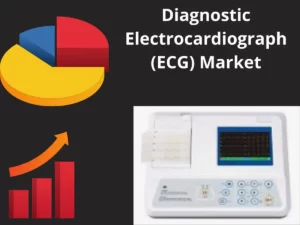© 2024 All rights reserved
Datavagyanik- Your Research Partner

An electrocardiograph is the most commonly used medical investigation for diagnosing fatal cardiovascular diseases. These abnormalities can range from a simple malfunction in the cardiac rhythm to myocardial ischemia and infarction. The heart is a significant organ that maintains the integrity of life. It is why diagnostic electrocardiograph shares a more significant fraction of the medical market. ECG market involves ECG machines crucial for the operation theatre and ambulances. In addition to ECG machines, personal devices such as smart-watches also offer ECG monitoring by assessing heart rate.
The research report titled “Diagnostic Electrocardiograph (ECG) Market, Business and Opportunity Analysis” published by Datavagyanik presents a detailed analysis of the Diagnostic Electrocardiograph (ECG) market with country-wise market statistics, qualitative insights and market player analysis. One of the prime objectives of the report is to provide an assessment of the market potential, market revenue, growth and business opportunities for Diagnostic Electrocardiograph (ECG) Market in each country.

In 2022, the global diagnostic electrocardiograph market size stands at $ 7.6 billion. It was growing at a compound annual growth rate of 5.5%. In the next forecast period that ends in 2030, it will exceed $12 billion if it keeps growing at this pace. From all of the above discussions, one thing is clear the diagnostic ECG market is showing a massive spike each year. It is because of the increased prevalence of cardiovascular diseases, advancing healthcare infrastructure, and high demand for technological medical devices.
What’s more important than an Electrocardiograph for the assessment of cardiovascular function? It’s a painless and non-invasive approach to diagnosing different heart problems. Health care providers use it for monitoring heart rhythms. Any rhythm deviating from the usual markings indicates the presence of abnormality. Such abnormalities can prove fatal if not timely treated.
A standard 12 leads ECG machine helps to locate the occluded coronary vessel leading to angina or heart attack. It is also essential for assessing the functioning of an artificial pacemaker implanted in the heart. Most importantly, about eight hundred thousand people experience a heart attack annually. These cases have been increasing with each passing year. An electrocardiograph is the most reliable way that helps in the early assessment of such patients hindering their unnecessary demise.
As already mentioned, heart patient cases are increasing globally. Therefore, the demand for diagnostic ECG is also showing an uprise. Moreover, it is not only restricted to only the diagnosis of heart abnormalities. The American Heart Association also suggests screening people with a positive family history of heart problems, even when they are not experiencing any symptoms.
In some patients, symptoms are not persistent instead intermittent, which tend to go away or return with time. For such patients, healthcare providers recommend a continuous or remote ECG machine that monitors the heart rhythm throughout the day.
The report analyzes Diagnostic Electrocardiograph (ECG) market from demand as well as supply side. In supply side analysis, we reach out to the Diagnostic Electrocardiograph (ECG) market players to collect information on their portfolio, revenue, target customers and other insights. During this process, paid interviews and surveys are conducted for obtaining and validating the data pointers. We also deep dive into the available paid industry databases, research studies, white papers and annual reports.
As a part of our demand side analysis, we reach out to the end users of Diagnostic Electrocardiograph (ECG), to gauge the application areas, demand trends and similar insights.
This business analysis report on the Diagnostic Electrocardiograph (ECG) market presents a regional as well as country level analysis. The regions covered in the report are – North America, Europe, Asia Pacific and Rest of the World. In these four regions, all the countries have been covered in detail with information on Diagnostic Electrocardiograph (ECG) market size, trends and forecast.
The report covers Diagnostic Electrocardiograph (ECG) market revenue and forecast for the period (2021 – 2028), by regions, (further split into countries):
Each market segment in terms of lead type, product type, and end-user has been studied in detail in the report.
Diagnostic electrocardiographs can involve different lead types. These include 12-lead, 6-lead, 5-lead, 3-lead, and single-lead ECG devices. Among these, 3-lead ECG devices are most commonly used due to their association with other uses related to cardiac diagnostic and treatment techniques. As evident from this discussion, the global market of 3-lead ECG devices is expected to show the most growth during the upcoming years.
Depending upon the product, diagnostic electrocardiographs can include stress devices, resting devices, and implantable loop recorders. The implantable loop devices are much more helpful in enhanced and rapid diagnosis. Their effectiveness makes them the ECG devices expected to show the most growth during the forecast period till 2030.
Hospitals, clinics, ambulatory surgical centers, and cardiac care centers are the primary end-users of the diagnostic electrocardiograph. Therefore, end-users are a particular factor that defines the market share of any product.
There has been a rise in patients’ visits to cardiac care centers and hospitals to diagnose cardiovascular anomalies due to the increasing prevalence of cardiovascular diseases. All this puts extra demand for ECG machines and services in hospitals and clinics. Hence these end users are responsible for the most significant share of the diagnostic ECG market.
DIAGNOSTIC ELECTROCARDIOGRAPH (ECG) MARKET REVENUE ($MILLION), AND FORECAST, 2021–2028
| Year | 2021 | 2022 | 2023 | 2024 | 2025 | 2026 | CAGR (2021-2028) |
| Diagnostic Electrocardiograph (ECG) Market Revenue ($Million) | XX | XX | XX | XX | XX | XX | XX |
| Total | XX | XX | XX | XX | XX | XX | XX |
*Note – Country level break-down has been covered in the report
Market revenue and forecast for the period (2021 – 2028), by Product:
Market revenue and forecast for the period (2021 – 2028), by Software and Service:
Market revenue and forecast for the period (2021 – 2028), by Lead Type:
Market revenue and forecast for the period (2021 – 2028), by End User:
Diagnostic Electrocardiograph (ECG) Market Player Analysis:
Some of the key market players profiled in the report are GE Healthcare (US), Nihon Kohden Corporation (Japan), Koninklijke Philips (Netherlands), Medtronic (Ireland), Hill-Rom Holdings (US), SCHILLER (Switzerland), BioTelemetry, Inc. (US), BPL Medical Technologies (India), ACS Diagnostics (US), SHENZHEN MINDRAY BIO-MEDICAL ELECTRONICS Co., Ltd. (China), BTL (US), Ambu A/S (Denmark), Allengers Medical Systems, Ltd. (India), FUKUDA DENSHI (Japan), Innomed Medical (Hungary), Edan Instruments, Inc. and others.
“Every Organization is different and so are their requirements”- Datavagyanik







© 2024 All rights reserved
Datavagyanik- Your Research Partner
Add the power of Impeccable research, become a DV client